
Rindge is a town in Cheshire County, New Hampshire, United States. The population was 6,476 at the 2020 census, up from 6,014 at the 2010 census. Rindge is home to Franklin Pierce University, the Cathedral of the Pines and part of Annett State Forest.

Mount Monadnock, or Grand Monadnock, is a mountain in the towns of Jaffrey and Dublin, New Hampshire. It is the most prominent mountain peak in southern New Hampshire and is the highest point in Cheshire County. It lies 38 miles (61 km) southwest of Concord and 62 miles (100 km) northwest of Boston. At 3,165 feet (965 m), Mount Monadnock is nearly 1,000 feet (305 m) higher than any other mountain peak within 30 miles (48 km) and rises 2,000 feet (610 m) above the surrounding landscape. Monadnock's bare, isolated, and rocky summit provides expansive views. It is known for being featured in the writings of Ralph Waldo Emerson and Henry David Thoreau.

The Cathedral Church of SS. Peter and Paul is the Roman Catholic cathedral of the city of Bristol. Located in the Clifton area of the city, it is the seat and mother church of the Diocese of Clifton and is known as Clifton Cathedral. It has been a Grade II* Listed Building since 2000. A 2014 study noted it to be the only Catholic church built in the 1970s to have been Grade II* listed. It was the first cathedral built under new guidelines arising from the Second Vatican Council.

The Monadnock Region is a region in southwestern New Hampshire. It is named after Mount Monadnock, a 3,165 foot isolated mountain, which is the dominant geographic landmark in the region. Although it has no specific borders, the Monadnock Region is generally thought of comprising all of Cheshire County and the western portion of Hillsborough County.

The Normandy American Cemetery and Memorial is a World War II cemetery and memorial in Colleville-sur-Mer, Normandy, France, that honors American troops who died in Europe during World War II. It is located on the site of the former temporary battlefield cemetery of Saint Laurent, covers 172.5 acres and contains 9,388 burials.

The Church of Our Lady and Saint Nicholas is the Anglican parish church of Liverpool. The site is said to have been a place of worship since at least the 1250s. The church is situated close to the River Mersey near the Pier Head. The Chapel of St Nicholas was built on the site of St Mary del Quay, which in 1355 was determined to be too small for the growing borough of Liverpool. It is recorded in the National Heritage List for England as a designated Grade II listed building, and is an active parish church in the diocese of Liverpool, the archdeaconry of Liverpool and the deanery of Liverpool North. It is part of the Greater Churches Group. From 1813 to 1868 the Church was the tallest building in Liverpool at 174 feet [53 m], but then surpassed by the Welsh Presbyterian Church in Toxteth.

Franklin Pierce University is a private university in Rindge, New Hampshire. It was founded as Franklin Pierce College in 1962, combining a liberal arts foundation with coursework for professional preparation.
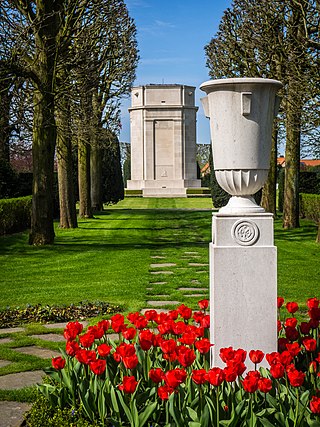
Flanders Field American Cemetery and Memorial is a World War I cemetery in the city of Waregem, Belgium. Originally a temporary battlefield burial ground, Flanders Field American Cemetery later became the only permanent American World War I cemetery in Belgium. The Flanders Field American Cemetery commemorates 411 service members of the United States Armed Forces of which 368 are interred. The Walls of the Missing inside the chapel venerates 43 missing service members.
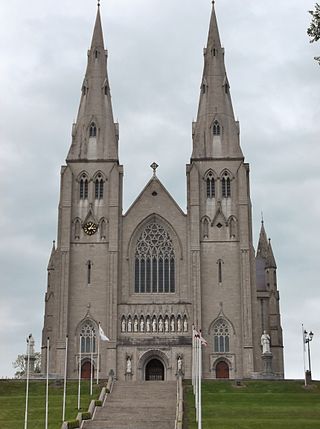
St. Patrick's Cathedral in Armagh, Northern Ireland is the seat of the Catholic Archbishop of Armagh, Primate of All Ireland. It was built in various phases between 1840 and 1904 to serve as the Roman Catholic Cathedral of the Archdiocese of Armagh, the original Medieval Cathedral of St. Patrick having been appropriated by the state church called the Church of Ireland at the time of the Irish Reformation.

St John's Cathedral is the cathedral of the Anglican Diocese of Brisbane and the metropolitan cathedral of the ecclesiastical province of Queensland, Australia. It is dedicated to St John the Evangelist. The cathedral is situated in Ann Street in the Brisbane central business district, and is the successor to an earlier pro-cathedral, which occupied part of the contemporary Queens Gardens on William Street, from 1854 to 1904. The cathedral is the second-oldest Anglican church in Brisbane, predated only by the extant All Saints church on Wickham Terrace (1862). The cathedral is listed on the Queensland Heritage Register.
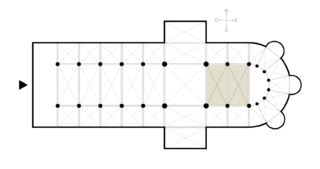
A choir, also sometimes called quire, is the area of a church or cathedral that provides seating for the clergy and church choir. It is in the western part of the chancel, between the nave and the sanctuary, which houses the altar and Church tabernacle. In larger medieval churches it contained choir-stalls, seating aligned with the side of the church, so at right-angles to the seating for the congregation in the nave. Smaller medieval churches may not have a choir in the architectural sense at all, and they are often lacking in churches built by all denominations after the Protestant Reformation, though the Gothic Revival revived them as a distinct feature.

Quimper Cathedral, formally the Cathedral of Saint Corentin, is a Roman Catholic cathedral and national monument of Brittany in France. It is located in the town of Quimper and is the seat of the Diocese of Quimper and Léon. Saint Corentin was its first bishop.

Cathedral Church of St Michael and St George serves as the Roman Catholic cathedral for the Bishopric of the Forces. Located on Queens Avenue in Aldershot, England, the building was originally intended to be the principal church for the Anglican chaplaincies of the British Army but since 1973 it has been the seat of the Roman Catholic Bishop of the Forces.
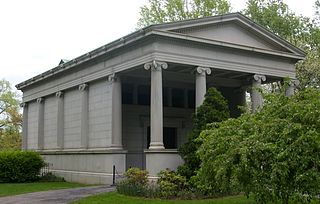
Wade Memorial Chapel is a Neoclassical chapel and receiving vault located at Lake View Cemetery in Cleveland, Ohio, in the United States. It was donated to the cemetery by Jeptha Wade II in memory of his grandfather, cemetery and Western Union co-founder Jeptha Wade. The overall design was by the newly-founded Cleveland area architectural firm of Hubbell & Benes, and was their first commission. The interior's overall design is by Louis Comfort Tiffany based on a preexisting 1893 design. The interior features two mosaics on the right and left hand walls, and a large stained glass window.

The Brittany American Cemetery and Memorial is located in Saint-James, Normandy, France, near the northeastern edge of Brittany. It contains the remains of 4,410 of World War II American soldiers, most of whom died in the Normandy and Brittany campaigns of 1944. Along the retaining wall of the memorial terrace are inscribed the names of 498 of the missing. Rosettes mark the names of soldiers whose remains have been identified.

Dol-de-Bretagne Cathedral is a Roman Catholic church located in Dol-de-Bretagne. The cathedral is dedicated to Saint Samson, one of the founding saints of Brittany. It was formerly the seat of the Archbishop of Dol, one of the nine ancient bishoprics of Brittany. The cathedral suffered badly from the excesses of the French Revolution, becoming successively a "Temple de la Raison", then a stable, then a warehouse. Revolutionaries caused considerable damage and many treasures were lost. When it eventually returned to being a house of worship, its role as a bishopric was abolished by the Concordat of 1801 when the Dol diocese was merged into the Dioceses of Rennes and Saint-Malo. The Concordat of 1801 was an agreement between Napoleon and Pope Pius VII, signed on 15 July 1801 in Paris, which sought national reconciliation between revolutionaries and Catholics. The Concordat was abrogated by the law of 1905 on the separation of church and state.

St George's Cathedral is the Anglican cathedral in Cape Town, South Africa, and the seat of the Archbishop of Cape Town. St. George's Cathedral is both the metropolitical church of the Anglican Church of Southern Africa and a congregation in the Diocese of Cape Town.

St Mary the Virgin, Acocks Green is a Grade II listed Church of England parish church in Acocks Green, Birmingham, England.
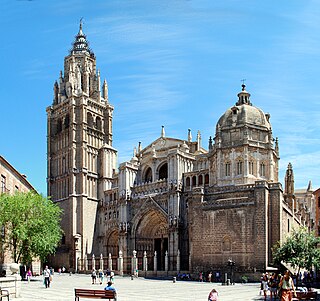
The Primatial Cathedral of Saint Mary of Toledo, otherwise known as Toledo Cathedral, is a Roman Catholic church in Toledo, Spain. It is the seat of the Metropolitan Archdiocese of Toledo.

Cathedral of St Michael and St John is a heritage-listed Roman Catholic cathedral at 107 William Street, Bathurst, Bathurst Region, New South Wales, Australia. It was designed by Charles Hansom and built from 1857 to 1861 by Edward Gell. It is also known as Cathedral of Saints Michael and John. The cathedral is the episcopal see of the Roman Catholic Bishop of Bathurst. The property is owned by the Roman Catholic Diocese of Bathurst. It was added to the New South Wales State Heritage Register on 5 June 2012.






















